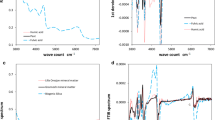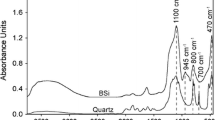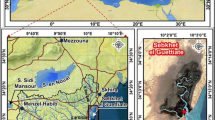Abstract
Reflectance spectroscopy has several advantages compared to traditional chemical methods in paleolimnology. It requires little cost, involves minimal or no sample preparation and is rapid. There has, however, been limited use of reflectance spectroscopy in polar paleolimnological studies. This paper explores the application of reflectance spectroscopy to reconstruct historical changes in penguin population size in the maritime Antarctic. Two ornithogenic sediment cores on Ardley Island, Antarctica were analyzed. Penguin droppings and weathered soils were analyzed as reference materials. Principal component analysis and linear mixing modeling were performed on the spectral data to estimate the proportion of penguin guano in the sediments and these values were used to infer historical penguin population numbers. Historical penguin population size versus time, reconstructed from reflectance spectra, and population numbers inferred from previous geochemical analysis of bio-elements, were quite similar. Our results illustrate the feasibility of rapidly inferring historical changes in penguin population size using reflectance spectroscopy on Antarctic ornithogenic sediments. Our findings suggest that this technique has potential for reconstructing past population numbers of other seabirds and mammals using lake sediments influenced by animal excrement.






Similar content being viewed by others
References
Ben-Dor E, Inbar Y, Chen Y (1997) The reflectance spectra of organic matter in the visible near infrared and short wave infrared region (400–2500 nm) during a controlled decomposition process. Remote Sens Environ 61:1–15
Birks HH, Birks HJB (2006) Multi-proxy studies in palaeolimnology. Veg Hist Archaeobot 15:235–251
Butkutė B, Šlepetienė A (2004) Near-infrared reflectance spectroscopy as a fast method for simultaneous prediction of several soil quality components. Chemija 15:12–20
Chang CW, Laird DA, Mausbach MJ, Hurburgh CR (2001) Near-infrared reflectance spectroscopy—principal components regression analyses of soil properties. Soil Sci Soc Am J 65:480–490
Chang CW, You CF, Huang CY, Lee TQ (2005) Rapid determination of chemical and physical properties in marine sediments using a near-infrared reflectance spectroscopic technique. Appl Geochem 20:1637–1647
Cohen MJ, Prenger JP, DeBusk WF (2005) Visible-near infrared reflectance spectroscopy for rapid, nondestructive assessment of wetland soil quality. J Environ Qual 34:1422–1434
Cozzolino D, Morón A (2006) Potential of near-infrared reflectance spectroscopy and chemometrics to predict soil organic carbon fractions. Soil Till Res 85:78–85
Das B (2007) Reconstruction of historical productivity using visible-near-infrared (VNIR) reflectance properties from boreal and saline lake sediments. Aquat Ecol 41:209–220
Das B, Vinebrooke RD, Sanchez-Azofeifa A, Rivard B, Wolfe AP (2005) Inferring sedimentary chlorophyll concentrations with reflectance spectroscopy: a novel approach to reconstructing historical changes in the trophic status of mountain lakes. Can J Aquat Sci 62:1067–1078
Foley WJ, Mcllwee A, Lawler I, Aragones L, Woolnough AP, Berding N (1998) Ecological applications of near infrared reflectance spectroscopy—a tool for rapid, cost-effective prediction of the composition of plant and animal tissues and aspects of animal performance. Oecologia 116:293–305
Font R, Del Río M, Vélez D, Montoro R, De Haroa A (2004) Use of near-infrared spectroscopy for determining the total arsenic content in prostrate amaranth. Sci Total Environ 327:93–104
Hodgson DA, Doran PT, Roberts D, McMinn A (2004) Paleolimnological studies from the Antarctic and sub Antarctic islands. In: Pienitz R, Douglas MSV, Smol JP (eds) Long-term environmental change in Arctic and Antarctic lakes. Developments in palaeoenvironmental research, vol 8. Springer, Dordrecht, pp 419–474
Huang T, Sun LG, Wang YH, Liu XD, Zhu RB (2009) Penguin population dynamics for the past 8500 years at Gardner Island, Vestfold Hills. Antarct Sci 21:571–578
King JC (1994) Recent climate variability in the vicinity of the Antarctic Peninsula. Int J Climatol 14:357–369
Kooistra L, Wehrens R, Leuven RSEW, Buydens LMC (2001) Possibilities of visible-near-infrared spectroscopy for the assessment of soil contamination in river floodplains. Anal Chim Acta 446:97–105
Korsman T, Nilsson M, Öhamn J, Renberg I (1992) Near-infrared reflectance spectroscopy of sediments: a potential method to infer the past pH of lakes. Environ Sci Technol 26:2122–2126
Korsman T, Nilsson MB, Landgren K, Renberg I (1999) Spatial variability in surface sediment composition characterized by near-infrared (NIR) reflectance spectroscopy. J Paleolimnol 21:61–71
Liu XD, Sun LG, Yin XB (2004) Textural and geochemical characteristics of proglacial sediments: a case study in the foreland of Nelson Ice Cap, Antarctica. Acta Geol Sin-Engl 78:970–981
Liu XD, Sun LG, Xie ZQ, Yin XB, Wang YH (2005) A 1300-year record of penguin populations at Ardley Island in the Antarctica, as deduced from the geochemical data in the ornithogenic lake sediments. Arct Antarct Alp Res 37:490–498
Liu XD, Li HC, Sun LG, Yin XB, Zhao SP, Wang YH (2006) δ13C and δ15N in the ornithogenic sediments from the Antarctic maritime as paleoecological proxies during the past 2000 years. Earth Planet Sci Lett 243:424–438
Liu XD, Sun LG, Xie ZQ, Yin XB, Zhu RB, Wang YH (2007) Preliminary geochemical record for the pre-historical seabird population in “Mochou” Lake sediments on the Larsemann Hills, East Antarctica. Boreas 36:182–197
Liu XD, Sun J, Sun LG, Liu WQ, Wang YH (2010) Feasibility of using reflectance spectroscopy for the analysis of bio-element concentrations in Antarctic ornithogenic sediments. Chin J Polar Sci 21:31–45
Malley DF, Williams PC (1997) Use of near-infrared reflectance spectroscopy in prediction of heavy metals in freshwater sediment by their association with organic matter. Environ Sci Technol 31:3461–3467
Malley DF, Rönicke H, Findlay DL, Zippel B (1999) Feasibility of using near-infrared reflectance spectroscopy for the analysis of C, N, P and diatoms in lake sediments. J Paleolimnol 21:295–306
Malley DF, Lockhart L, Wilkinson P, Hauser B (2000) Determination of carbon, carbonate, nitrogen, and phosphorus in freshwater sediments by near-infrared reflectance spectroscopy: rapid analysis and a check on conventional analytical methods. J Paleolimnol 24:415–425
Michelutti N, Wolfe AP, Vinebrooke RD, Rivard B, Briner JP (2005) Recent primary production increases in arctic lakes. Geophys Res Lett 32:L19715. doi:10.1029/2005GL023693
Michelutti N, Blais JM, Cumming BF, Paterson AM, Rühland K, Wolfe AP, Smol JP (2010) Do spectrally inferred determinations of chlorophyll α reflect trends in lake trophic status? J Paleolimnol 43:205–217
Morón A, Cozzolino D (2004) Determination of potentially mineralizable nitrogen and nitrogen in particulate organic matter fractions in soil by visible and near-infrared reflectance spectroscopy. J Agric Sci 142:335–343
Murray I (1986) The NIR spectra of homologous series of organic compounds. In: Hollo J, Kaffka KJ, Gonczy JL (eds) Proceedings of the international NIR/NIT conference. Akademiai Kiado, Budapest, pp 13–28
Nilsson MB, Dåbakk E, Korsman T, Renberg I (1996) Quantifying relationships between near-infrared reflectance spectra of lake sediments and water chemistry. Environ Sci Technol 30:2586–2590
Osborne BG, Fearn T, Hindle PH (1993) Practical NIR spectroscopy with applications in food and beverage analysis. Longman Scientific and Technical, Harlow, UK, pp 13–35
Pasquini C (2003) Near infrared spectroscopy: fundamentals, practical aspects and analytical applications. J Braz Chem Soc 14:198–219
Richardson AD, Reeves JB III (2005) Quantitative reflectance spectroscopy as an alternative to traditional wet lab analysis of foliar chemistry: near-infrared and mid-infrared calibrations compared. Can J For Res 35:1122–1130
Richardson AD, Reeves JB III, Gregoire TG (2003) Multivariate analyses of visible/near infrared (VIS/NIR) absorbance spectra reveal underlying spectral differences among dried, ground conifer needle samples from different growth environments. New Phytol 161:291–301
Rosén P (2005) Total organic carbon (TOC) of lake water during the Holocene inferred from lake sediments and near-infrared spectroscopy (NIRS) in eight lakes from northern Sweden. Biogeochemistry 76:503–516
Rosén P, Dåbakk E, Renberg I, Nilsson M, Hall R (2000) Near-infrared spectrometry (NIRS): a new tool for inferring past climatic changes from lake sediments. The Holocene 10:161–166
Sørensen LK, Dalsgaard S (2005) Determination of clay and other soil properties by near infrared spectroscopy. Soil Sci Soc Am J 69:159–167
Sun LG, Xie ZQ (2001) Relics: penguin population programs. Sci Prog 84:31–44
Sun LG, Xie ZQ, Zhao JL (2000) A 3, 000-year record of penguin populations. Nature 407:858
Sun LG, Xie ZQ, Zhao JL (2001) The sediments of lake on the Ardley Island, Antarctic: identification of penguin-dropping soil. Chin Jour Polar Sci 12:1–8
Sun LG, Zhu RB, Yin XB, Liu XD, Xie ZQ, Wang YH (2004) A geochemical method for reconstruction of the occupation history of penguin colony in the maritime Antarctic. Polar Biol 27:670–678
Sun LG, Zhu RB, Liu XD, Xie ZQ, Yin XB, Zhao SP, Wang YH (2005) HCl-soluble 87 Sr/86Sr ratio in the sediments impacted by penguin or seal excreta as a proxy for the size of historical population in the maritime Antarctic. Mar Ecol-Prog Ser 303:43–50
Sun LG, Xie ZQ, Liu XD, Yin XB, Zhu RB (2006) Eco-geology in Antarctic ice-free areas. Science Press, Beijing, pp 1–306 (in Chinese)
Trivelpiece WZ, Trivelpiece SG, Volkman NJ (1987) Ecological segregation of Adelie, Gentoo, and Chinstrap penguins at King George Island, Antarctica. Ecology 68:351–361
Turner J, King JC, Lachlan-Cope TA, Jones PD (2002) Recent temperature trends in the Antarctic. Nature 418:291–292
Vaughan DG, Marshall GJ, Connolley WM, Parkinson C, Mulvaney R, Hodgson DA, King JC, Pudsey CJ, Turner J (2003) Recent rapid regional climate warming on the Antarctic Peninsula. Clim Change 60:243–274
Wang JJ, Wang YH, Wang XM, Sun LG (2007) Penguins and vegetations on Ardley Island, Antarctica: evolution in the past 2, 400 years. Polar Biol 30:1475–1481
Wolfe AP, Vinebrooke RD, Michelutti N, Rivard B, Das B (2006) Experimental calibration of lake-sediment spectral reflectance to chlorophyll α concentrations: methodology and paleolimnological validation. J Paleolimnol 36:91–100
Wu YZ, Chen J, Ji JF, Tian QJ, Wu XM (2005) Feasibility of reflectance spectroscopy for the assessment of soil mercury contamination. Environ Sci Technol 39:873–878
Xia XQ, Mao YQ, Ji JF, Ma HR, Chen J, Liao QL (2007) Reflectance spectroscopy study of Cd contamination in the sediments of the Changjiang River, China. Environ Sci Technol 41:3449–3454
Acknowledgments
We thank the Chinese Antarctic and Arctic Administration of National Oceanic Bureau for logistical support. This study was supported by the National Natural Science Foundation (Grant Nos. 40876096, 41076123, 40730107 and 40606003), open research fund from SOA Key Laboratory for Polar Science (KP2007002), the young fund for strategic research of the Chinese Polar Sciences from CAAA (No. 20070202), and the special fund for excellent PhD theses of CAS. We especially appreciate three anonymous reviewers for their critical reviews and careful corrections of this manuscript.
Author information
Authors and Affiliations
Corresponding author
Rights and permissions
About this article
Cite this article
Liu, X., Sun, J., Sun, L. et al. Reflectance spectroscopy: a new approach for reconstructing penguin population size from Antarctic ornithogenic sediments. J Paleolimnol 45, 213–222 (2011). https://doi.org/10.1007/s10933-010-9493-6
Received:
Accepted:
Published:
Issue Date:
DOI: https://doi.org/10.1007/s10933-010-9493-6




